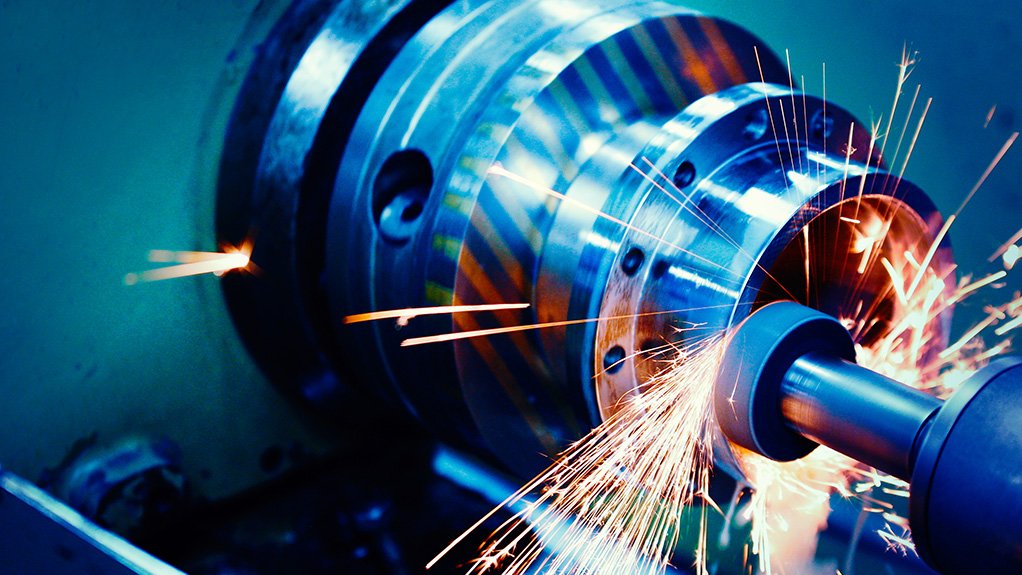Metals, engineering output up 1.7% but still far below 2008/9 peak
While aggregate production in the South African metals and engineering sector increased by 1.7% last year, which is slightly higher than the 1.5% increase in 2022, it remains 18% below where it was in 2008/9.
Overall, the 2023 index of production averaged about 4.2% below its long-term average.
These statistics were revealed in the ‘State of the Metals and Engineering Sector Report 2024’, which the Steel and Engineering Industries Federation of Southern Africa (Seifsa) released on February 20.
The report explores the current state of the metals and engineering sector, which constitutes about 26.2% of South Africa’s manufacturing sector based on output, amid moderating inflation and heightened geopolitical tension.
Speaking during the online launch, Seifsa COO Tafadzwa Chibanguza said the overall outlook for the metals and engineering sector for this year was not as bleak as it was last year, but he warned that local and global risks remained high.
“Production has also not sustainably attained its pre-Covid-19 lockdown levels and has been oscillating between one and two index points around this level,” Chibanguza said.
He added that this was amid the expectation for global economic growth to flatline into the medium term, which presents a neutral perspective on demand prospects from the external environment.
“Growth is primarily tilted in favour of the advanced economies, which presents limited export potential given that sub-Saharan Africa is the largest export market for the sector,” Chibanguza explained.
He said the geopolitical risks of concern included, on a global scale, the ongoing conflicts in Europe and the Middle East, while locally the sector faces persistent loadshedding; logistical challenges, including the crisis at Transnet; deteriorating service delivery at municipal level; wage negotiations; and the uncertainty of an election year, along with the political noise that precedes it.
“Whatever the outcome of the election, it presents risk as a lot of work has been done in terms of policy, such as energy and public procurement, for example. A new administration means dealing with new members of Parliament and a new Cabinet,” he noted.
The capacity use within the metals and engineering sector was also recorded at lower than optimal levels, coming in at about 75.3%.
“Often what we are looking for is 85%, which is the optimal level of full capacity. We are still far from that,” Chibanguza said.
Linked to this, the 362 871 employees in the sector in 2023 represented a 2% decline in employment levels year-on-year and a 37.2% decline since 2008, when 577 507 employees were recorded in the sector.
However, employee compensation went up by 1.5% from 2022 to 2023, amounting to R113.9-billion. As it stands, labour costs make up 18% of total input costs.
“The link between production and employment has continued to weaken, and an increase in production is becoming less of a sufficient reason for increases in employment,” Chibanguza said, explaining that the latest estimates indicated that a 5% increase in production would result in a 1.2% increase in employment.
“Periods of structural shock have also shown evidence of worsening this relationship,” he added, pointing to the global financial crisis, Covid-19 and incidents of industrial action.
In terms of investment within the metals and engineering sector, he revealed that gross investment had increased by 33.5% between 2021 and 2022 to R27.1-billion. However, net investment decreased by R2.3-billion.
“Net investment has remained negative since 2008. Fixed capital stock deteriorated by -1.2% between 2021 and 2022. On a compound basis, it has deteriorated at a rate of -0.8%,” he explained.
On the positive side, he noted that inflation was subsiding faster than expected, particularly in advanced economies, which he believed should allow for hard currency rate cuts, which would set the scene for global monetary policy.
“In 2023, input cost inflation averaged 5.23%, considerably lower than the average of 2022, which was 13.5%,” Chibanguza said.
However, he pointed out that input costs last year were 3.9 percentage points above factory gate prices, which represented considerable margin compression.
Global inflation is set to decline from 6.8% in 2023 to 5.8% this year, and 4.4% in 2025, which he believes will provide a way for interest rates to start coming down. Declining interest rates, in turn, will present a scenario for investment in the economy to start picking up. This will result in stronger demand for the products and services of the metals and engineering sector.
This scenario will also lead to a decrease in the pressure on debt service costs for the state, possibly creating fiscal headroom for the government to spend more, injecting the economy with the energy and funding it needs to increase demand for the metals and engineering sector.
Lower interest rates will also provide room for companies in the metals and engineering sector to invest into their operations, which is particularly important given the negative net investment trend that has underpinned the sector since 2008, which has also resulted in the sector's fixed capital stock deteriorating at a compound annual growth rate of 0.8% over the same period.
Chibanguza said that, while work had been done to revive the economy, reforms took time for their full effect to be realised, and the sector’s potential would remain constrained as long as too many local companies remained in survival mode owing to the many challenges they faced.
“The downside risks are both on the supply and demand side, complicating the nature of the problem facing the sector even more,” he concluded.
Article Enquiry
Email Article
Save Article
Feedback
To advertise email advertising@creamermedia.co.za or click here
Comments
Press Office
Announcements
What's On
Subscribe to improve your user experience...
Option 1 (equivalent of R125 a month):
Receive a weekly copy of Creamer Media's Engineering News & Mining Weekly magazine
(print copy for those in South Africa and e-magazine for those outside of South Africa)
Receive daily email newsletters
Access to full search results
Access archive of magazine back copies
Access to Projects in Progress
Access to ONE Research Report of your choice in PDF format
Option 2 (equivalent of R375 a month):
All benefits from Option 1
PLUS
Access to Creamer Media's Research Channel Africa for ALL Research Reports, in PDF format, on various industrial and mining sectors
including Electricity; Water; Energy Transition; Hydrogen; Roads, Rail and Ports; Coal; Gold; Platinum; Battery Metals; etc.
Already a subscriber?
Forgotten your password?
Receive weekly copy of Creamer Media's Engineering News & Mining Weekly magazine (print copy for those in South Africa and e-magazine for those outside of South Africa)
➕
Recieve daily email newsletters
➕
Access to full search results
➕
Access archive of magazine back copies
➕
Access to Projects in Progress
➕
Access to ONE Research Report of your choice in PDF format
RESEARCH CHANNEL AFRICA
R4500 (equivalent of R375 a month)
SUBSCRIBEAll benefits from Option 1
➕
Access to Creamer Media's Research Channel Africa for ALL Research Reports on various industrial and mining sectors, in PDF format, including on:
Electricity
➕
Water
➕
Energy Transition
➕
Hydrogen
➕
Roads, Rail and Ports
➕
Coal
➕
Gold
➕
Platinum
➕
Battery Metals
➕
etc.
Receive all benefits from Option 1 or Option 2 delivered to numerous people at your company
➕
Multiple User names and Passwords for simultaneous log-ins
➕
Intranet integration access to all in your organisation

















